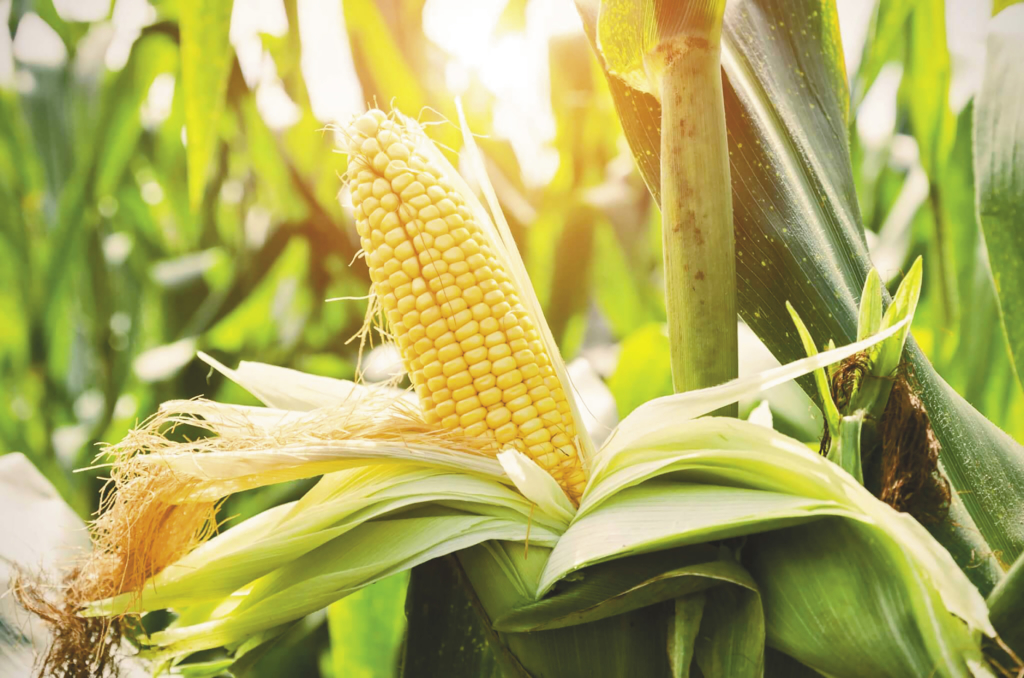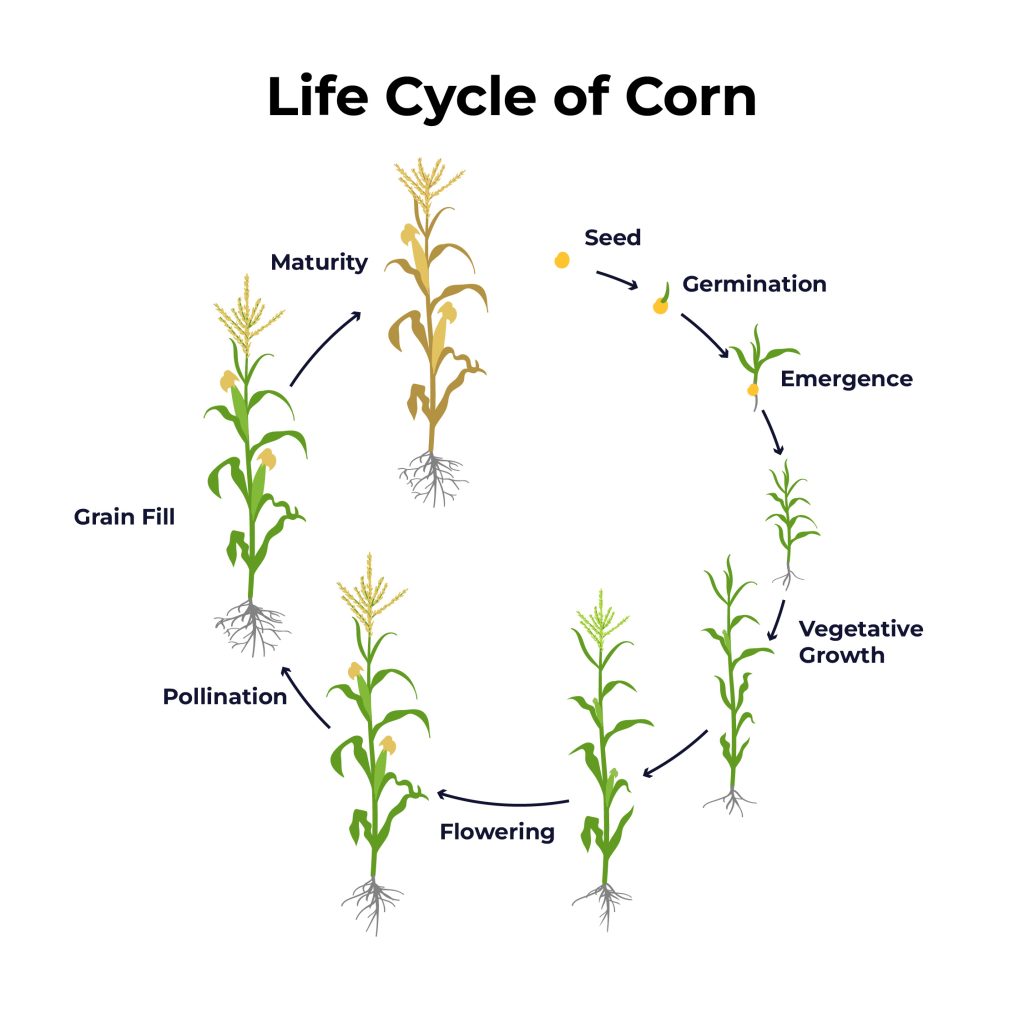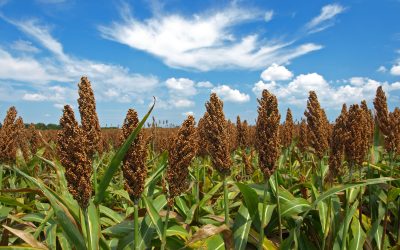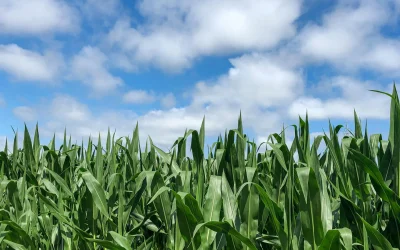Key Takeaways
- Vegetative growth sets the stage for yield. Proper management from VE to VT is critical for establishing a strong corn crop before pollination and grain fill.
- Corn’s vegetative growth stages are leaf-based. A new vegetative stage begins when a fully visible leaf collar appears, helping you track development in the field.
- Uniform crop emergence is key. Delayed emergence can reduce yield significantly. Use seed treatments, manage planting depth and wait for warm soils to optimize crop emergence.
- Early nutrition supports strong starts. Starter fertilizer and early nitrogen applications can fuel root development and early growth in corn.
- Tissue sampling helps fine-tune nutrition. Early vegetative stages are ideal for identifying and correcting nutrient deficiencies in-season.
- Scout early and often. Watch for seedling and foliar diseases, insects and weed competition during vegetative growth stages.
- V4–V6 is a critical window. This is when the plant sets ear row number and begins forming reproductive structures; stress can limit yield potential at this time.
- Rapid growth increases nutrient demand. From V6 to V12, corn rapidly accumulates nitrogen; side-dress early to support this nutrient demand.
- Moisture matters more as growth accelerates. Late vegetative stages require high water intake; irrigate strategically to avoid stress.
- VT signals the shift to reproduction. The tassel emerges and pollination begins; maintain plant health with timely fungicide applications if needed.
Proper management during a corn crop’s vegetative growth stages (VE to VT) is crucial for establishing a solid foundation for pollination and grain fill. While you may already know about the various vegetative growth stages in corn, you might not fully understand what is happening at each stage. Understanding your crop’s development can enable you to make informed management decisions during these critical growth periods. Let’s explore the vegetative growth stages in corn.
Establishing Vegetative Growth Stages In Corn
As soon as your corn crop emerges at the VE stage, it begins vegetative growth. Determining vegetative growth stages is relatively simple. As new leaves emerge and a full leaf collar is visible, your crop enters a new vegetative growth stage.
For example, in the photo below, you can see a developing corn crop. Four of the leaves have a visible leaf collar (LC). Therefore, this crop is at the V4 growth stage. Notice the top leaf is beginning to unfurl, but its leaf collar is not visible.

Source: Purdue University1
How Long Does Corn Progress Through Vegetative Stages?
Typically, a corn crop progresses through each vegetative stage relatively quickly. In favorable growing conditions, corn can add a new leaf every 3 to 4 days early in the season. As temperatures warm and the crop grows larger, development progresses more rapidly. Once the corn reaches about knee height, it can advance a growth stage every 2 to 3 days under optimum conditions. The number of vegetative stages will depend on how many leaves the hybrid produces, but most modern hybrids typically have 18 to 20 leaves (silage hybrids may produce more leaves).
Early Vegetative Stages (VE to V6)
VE – Emergence
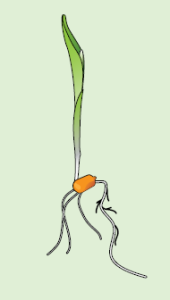
Source: Kansas State University2
Under optimal conditions, a corn crop can emerge within a week of planting. Emergence timing largely depends on the soil temperature and moisture availability. Planting early into cool soils can delay emergence by up to a month, which can negatively impact crop health and yield potential.
What’s happening
At emergence, the coleoptile (protected shoot) breaks through the soil surface. Once it is exposed to sunlight, expansion of the inner leaves begins, and the first true leaf emerges from the tip of the coleoptile.
Key management considerations
Emergence is one of the most critical developmental stages for the corn crop. When plants consistently emerge at the same time, yield potential is maximized. Multi-year research by Precision Planting shows that a plant that emerges two days later than the first emerging corn plant in a field suffers more than a 70% yield reduction.3
Many factors can inhibit optimal crop emergence, including:
- Cool soil temperatures
- Poor soil conditions for seed-to-soil contact
- Improper planting depth
- Too little or too much soil moisture
- Herbicide injury to the seedling
- Insect and disease pressure
- Excessive crop residue
Set your corn crop up for strong emergence by considering a seed treatment for early planting, waiting for soil temperatures to warm to at least 50 degrees and monitoring soil moisture. A starter fertilizer applied at planting can provide an early-season nutrient boost, promoting faster and more vigorous emergence.
Applying pre-emergence herbicides with residual activity before or soon after planting can reduce weed competition during the crop’s early development to ensure a strong start to the season.
V1 – V3
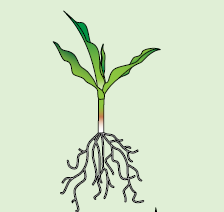
Source: Kansas State University2
What’s happening
V1 marks the start of leaf emergence, which sets the plant up to begin photosynthesis at the V3 growth stage. At V1, the lowest leaf has a visible collar, and the leaf tip is rounded. The plant still relies heavily on stored nutrients from the seed for energy until the V3 stage. At V3, the nodal roots begin to provide the growing plant with access to vital nutrients and moisture to sustain further vegetative growth, while the seminal roots cease growth.
Key management considerations
Supporting root development at this stage is critical. TerraFlow® by UpTerra is an irrigation technology that enhances subsurface moisture movement, helping young plants access water and nutrients more efficiently as nodal roots begin to develop. Corn growers who integrate TerraFlow into their irrigation programs have noticed improved root health, which helps increase water use efficiency and creates more root channels to facilitate water movement. These benefits allow corn growers to irrigate less while maintaining or improving their yield potential.
Getting the crop off to a strong start can have season-long benefits. Therefore, it’s important to continue scouting for weeds and early-season pests as leaf emergence begins. Common insects to watch for include white grubs, corn flea beetles and wireworms. Cool, wet soils can cause seedling diseases from Pythium, Fusarium and Rhizoctonia fungal pathogens.
The plant’s growing point is still underground at these early growth stages, providing some protection against hail, wind and frost that can injure the crop at later growth stages.
V4 to V6

Source: Kansas State University2
What’s happening
Approximately three weeks after emergence, the crop will enter the V4 growth stage. V4 to V6 is a critical developmental window for the crop, as it marks the initiation of the crop’s reproductive structures, including the tassel and ear.
By V5 or V6, the number of ear rows for the uppermost corn ear (ear girth) is determined, and the number of individual kernels per row begins to be determined (ear length). Genetics primarily determines ear girth, while environmental conditions more heavily influence ear length during the vegetative stages. By V6, the root system is well-established and distributed in the soil profile, and the nodal roots become the major supplier of water and nutrients to the plant.
Key management considerations
Post-emergence weed control should be a top priority from V4 to V6. Continue to scout for weeds and apply herbicides that address the weed spectrum in your fields. Try to manage weeds before they reach 4 inches in height for the most effective control.
The early vegetative stages in corn are a great time to conduct tissue sampling to help identify crop nutrient deficiencies. Sampling early allows time for in-season nutrient applications that can help maximize yield potential.
At V6, the plant’s growing point is aboveground, making the crop more susceptible to cold temperatures, hail and wind.
Mid-Vegetative Stages (V7 – V11)
V7 to V11

Source: Kansas State University2
What’s happening
Between V7 and V10, the corn crop enters a stage of rapid growth and stem elongation. New leaves will appear every two to three days after the V10 growth stage, and the demand for water and nutrients increases to support crop growth. By V10, ear shoots are visible on corn stalks. The developing tassel may also be visible by the V10 growth stage. Macro and micronutrient deficiencies may begin to show, and environmental stress from extreme heat, drought and pest pressure can slow development.
Key management considerations
The crop begins a rapid accumulation of nitrogen in leaves and stems, which it will later remobilize to the ears during grain fill. About 25% of the corn crop’s nitrogen uptake for the season takes place between the V6 and V12 growth stages, so sidedressing nitrogen before the V8 growth stage can help support the plant’s rapid growth.4 TerraFlow can help maximize the efficiency of nitrogen and other nutrient uptake during this high-demand period by enhancing soil moisture balance in the root zone.
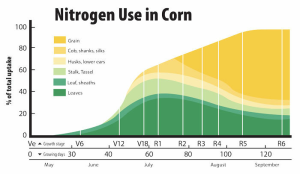
Source: No-Till Farmer4
Continue scouting fields for foliar diseases like Goss’s wilt and eyespot, and insects, including corn rootworm larvae that can compromise root health.
Late Vegetative Stages (V12 – VT)
V12 to V(n)
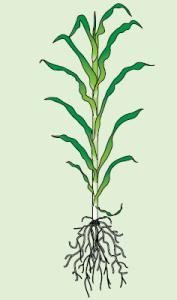
Source: Kansas State University2
What’s happening
The crop continues vegetative growth, adding new leaves until the tassel becomes visible. Development after the V12 growth stage largely depends on the crop’s maturity. Generally, grain corn develops between 18 and 22 leaves, with fuller maturity hybrids adding more leaves than those maturing earlier.
The crop reaches its peak water demand at tasseling, requiring up to ¼ inch of water per day.5 From V12 to VT, the plant will take up about 40% of its seasonal nitrogen requirement.4 Water stress and nutrient deficiencies during this time can significantly reduce the crop’s yield potential.
Key management considerations
Ensure the crop has adequate nutrients and moisture ahead of reproductive development. Irrigated farms should schedule watering events to meet high moisture demands during the late vegetative growth stages.
TerraFlow® by UpTerra can help optimize water use efficiency during peak water demand growth stages. TerraFlow uses vortexing and frequency transmission technologies to enhance moisture distribution in the soil and plants. This helps ensure roots can harness more available water and nutrients from the soil to keep up with rapid growth. Corn farmers who’ve used TerraFlow have seen significant improvements in vegetative growth, root mass development and yield potential.
Continue to scout fields for foliar diseases, such as tar spot, northern corn leaf blight and gray leaf spot as the crop approaches tasseling. Begin planning for fungicide applications if warranted.
VT – Tasseling
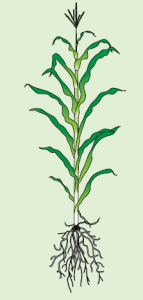
Source: Kansas State University2
What’s happening
The VT stage starts when the final branch of the tassel becomes visible, signaling the beginning of pollination. Anthers on the tassel begin to shed pollen, and within a couple of days, silks will emerge to pollinate individual ovules on the developing ear.
Key management considerations
Moisture management plays a key role at tasseling. Drought stress can cause asynchronous pollination, where pollen shed and silk emergence occur at different times. This results in incomplete pollination and fewer kernels per ear. Michigan State University reports that four consecutive days of visible plant wilting due to insufficient moisture at this time can lead to a 10-25% yield reduction.6 Leveraging irrigation technologies like TerraFlow at this stage can help maintain consistent soil moisture, reducing the risk of stress-related pollination issues.
Many growers choose to apply fungicides between VT and R1 to maximize ROI potential and protect plant health ahead of grain fill. Fungicide applications can help plants maintain green plant tissue longer, thereby maximizing photosynthesis and yield potential. Fungicides also support stalk health, enhancing crop standability throughout the growing season until harvest.
Optimize Vegetative Growth in Corn
Proper management during a corn crop’s vegetative growth stages—VE through VT—is essential for maximizing yield potential and setting up successful reproductive development. Each growth stage plays a distinct role in plant development, from establishing strong roots and nutrient uptake to initiating ear and tassel formation. Understanding what’s happening in your corn crop at every vegetative growth stage allows you to make timely, informed management decisions that directly impact crop yield.
Looking to enhance your crop’s vegetative performance? Discover how TerraFlow can support root development, nutrient uptake, moisture distribution and early-season plant vigor to help your corn thrive through every vegetative stage. Contact your local UpTerra sales representative to learn how TerraFlow can fit into your crop management plan.
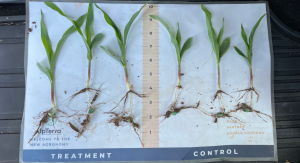
Corn from an Oklahoma farm. TerraFlow-treated corn (left) had stronger emergence, more leaf area and larger root masses at the V1 growth stage compared to untreated corn.
| Growth Stage | TerraFlow Benefit |
| VE-V3 | Supports emergence, early root access to water/nutrients |
| V4-V6 | Enhances nutrient uptake during rapid development |
| V7-V11 | Optimizes water/nitrogen use efficiency |
| V12-VT | Maintains moisture during peak crop demand |
| VT | Reduces pollination stress with more consistent soil moisture distribution |
References
1 Purdue University. Determining Corn Leaf Stages. 2019.
2 Kansas State University. Corn Growth and Development. 2016.
3 Precision Planting. Multi-Year Day of Emergence Corn Study. 2024.
4 Newman, N. Spoon-Feeding Nitrogen: Getting the Most Bang for Your Buck. No-Till Farmer. 2022.
5 South Dakota State University Extension. Corn Best Management Practices. 2019.
6 Thelen, K. Four Fundamental Stages of Corn Grain Yield Determination. Michigan State University Extension. 2007.

